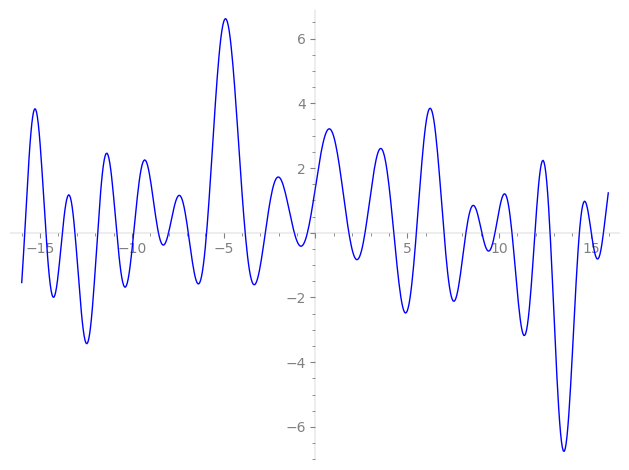| L(s) = 1 | − 11.3·2-s + (50.9 − 63i)3-s + 128.·4-s + (−576 + 712. i)6-s − 2.78e3i·7-s − 1.44e3·8-s + (−1.37e3 − 6.41e3i)9-s − 2.24e4i·11-s + (6.51e3 − 8.06e3i)12-s − 1.31e4i·13-s + 3.15e4i·14-s + 1.63e4·16-s + 6.63e4·17-s + (1.55e4 + 7.25e4i)18-s − 1.44e5·19-s + ⋯ |
| L(s) = 1 | − 0.707·2-s + (0.628 − 0.777i)3-s + 0.500·4-s + (−0.444 + 0.549i)6-s − 1.16i·7-s − 0.353·8-s + (−0.209 − 0.977i)9-s − 1.53i·11-s + (0.314 − 0.388i)12-s − 0.460i·13-s + 0.820i·14-s + 0.250·16-s + 0.794·17-s + (0.148 + 0.691i)18-s − 1.10·19-s + ⋯ |
\[\begin{aligned}\Lambda(s)=\mathstrut & 150 ^{s/2} \, \Gamma_{\C}(s) \, L(s)\cr =\mathstrut & (-0.976 - 0.214i)\, \overline{\Lambda}(9-s) \end{aligned}\]
\[\begin{aligned}\Lambda(s)=\mathstrut & 150 ^{s/2} \, \Gamma_{\C}(s+4) \, L(s)\cr =\mathstrut & (-0.976 - 0.214i)\, \overline{\Lambda}(1-s) \end{aligned}\]
Particular Values
| \(L(\frac{9}{2})\) |
\(\approx\) |
\(1.413568621\) |
| \(L(\frac12)\) |
\(\approx\) |
\(1.413568621\) |
| \(L(5)\) |
|
not available |
| \(L(1)\) |
|
not available |
\(L(s) = \displaystyle \prod_{p} F_p(p^{-s})^{-1} \)
| $p$ | $F_p(T)$ |
|---|
| bad | 2 | \( 1 + 11.3T \) |
| 3 | \( 1 + (-50.9 + 63i)T \) |
| 5 | \( 1 \) |
| good | 7 | \( 1 + 2.78e3iT - 5.76e6T^{2} \) |
| 11 | \( 1 + 2.24e4iT - 2.14e8T^{2} \) |
| 13 | \( 1 + 1.31e4iT - 8.15e8T^{2} \) |
| 17 | \( 1 - 6.63e4T + 6.97e9T^{2} \) |
| 19 | \( 1 + 1.44e5T + 1.69e10T^{2} \) |
| 23 | \( 1 - 4.93e4T + 7.83e10T^{2} \) |
| 29 | \( 1 + 6.27e5iT - 5.00e11T^{2} \) |
| 31 | \( 1 - 7.28e5T + 8.52e11T^{2} \) |
| 37 | \( 1 - 1.96e6iT - 3.51e12T^{2} \) |
| 41 | \( 1 + 9.86e5iT - 7.98e12T^{2} \) |
| 43 | \( 1 + 7.81e4iT - 1.16e13T^{2} \) |
| 47 | \( 1 - 3.51e6T + 2.38e13T^{2} \) |
| 53 | \( 1 - 5.22e5T + 6.22e13T^{2} \) |
| 59 | \( 1 + 5.00e6iT - 1.46e14T^{2} \) |
| 61 | \( 1 - 1.75e7T + 1.91e14T^{2} \) |
| 67 | \( 1 - 1.71e7iT - 4.06e14T^{2} \) |
| 71 | \( 1 + 2.58e7iT - 6.45e14T^{2} \) |
| 73 | \( 1 - 2.81e7iT - 8.06e14T^{2} \) |
| 79 | \( 1 + 9.18e6T + 1.51e15T^{2} \) |
| 83 | \( 1 + 8.71e7T + 2.25e15T^{2} \) |
| 89 | \( 1 + 8.12e7iT - 3.93e15T^{2} \) |
| 97 | \( 1 - 1.28e8iT - 7.83e15T^{2} \) |
| show more | |
| show less | |
\(L(s) = \displaystyle\prod_p \ \prod_{j=1}^{2} (1 - \alpha_{j,p}\, p^{-s})^{-1}\)
Imaginary part of the first few zeros on the critical line
−10.82157430337647573175744577525, −9.899427017861292610570758643106, −8.553545755344400501191963963352, −8.001320562840293722240045094473, −6.92871521355881107835307325288, −5.93055763922326190784534839503, −3.82822567003035189511416410945, −2.73207547286675500840791163300, −1.15188897042042138806718193153, −0.43837992888791853954738101761,
1.81980680388451643924487748196, 2.69969890805748187530390716867, 4.26782028542742243109326288436, 5.49653776285861940623867011876, 7.00058564630968667360268406269, 8.197370319864419229243457995692, 9.064327952537826042398224258334, 9.779763394916258849110823297682, 10.70381568366263765666196026744, 11.95601681092996678832489017778

